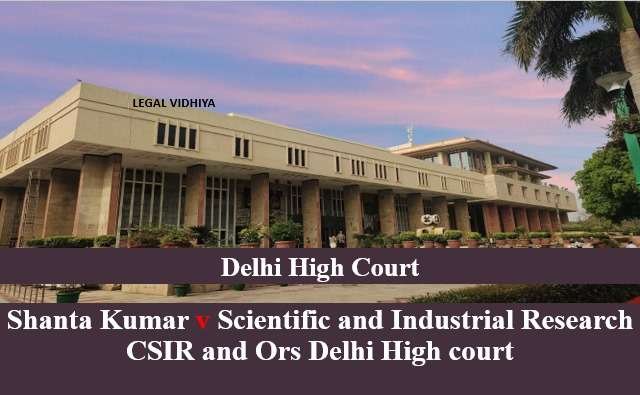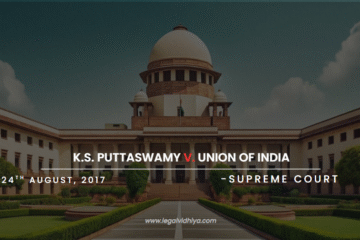
This article is written by Rupali Sharma of 5th semester of The Law School University of Jammu an intern under Legal Vidhiya.
Abstract
The case of “Shanta Kumar v Scientific and Industrial Research (CSIR) and Ors” involves a thorough examination of legal aspects, likely encompassing issues related to workplace sexual harassment. The case may delve into matter of legal principles, which deals with women safety and prevention of Sexual Harassment at workplace. This article is an important reminder to organizations of the importance of preventing workplace harassment. It supports the important role of strong POSH laws, preventive measures and a commitment to a safe and inclusive workplace.[1] This article delves into the legal intricacies surrounding the landmark case of “Shanta Kumar v Scientific and Industrial Research (CSIR) and Ors.” , a key legal battle to prevent sexual harassment of women in the workplace. The case, which unfolded against a backdrop of evolving social norms and legislative progress, marks a critical milestone in workplace safety and gender justice jurisprudence. A detailed analysis would be essential to understand the implications and outcomes of this legal confrontation.
The aim of the article is to offer an exact view of the case of Shanta Kumar v Scientific and Industrial Research (CSIR) and Ors. And highlight its importance in shaping the discourse on preventing and addressing sexual harassment in workplaces in India.
Keywords
Sexual Harassment, legislative progress, milestone, justice jurisprudence, implications, legal confrontation.
Introduction
Sexual violence is a serious and deep-rooted problem that transcends geography, culture and health and affects people from all walks of life. Recognizing the urgent need to address this issue in the workplace, countries around the world have implemented laws to protect people from bullying and create an environment of respect, dignity and equality.[2] An important piece of legislation is the Prevention of Sexual Harassment Act, which aims to support victims, raise awareness and keep the workplace harassment-free.
The law regarding harassment in the workplace has evolved and made progress. Events that lead to change. Among them, Shanta Kumar v Scientific and Industrial Research CSIR and Ors. emerged as an important case at the intersection of law, gender and technology. This article reveals the complexity of this and explores its implications for preventing harassment against women in the workplace in India. This document is the focus of many cases of harassment against women in the workplace.
This article explores the impact of discretion on setting workplace policies, the role of internal complaints procedures, and employers’ responsibilities in providing a safe and barrier-free environment. It also discusses the socio-legal implications of the case and shows its impact on women’s thinking, behavior and empowerment on social media. This article supports ongoing debates about gender justice, workplace equality and the changing role of justice in promoting safe and inclusive work.
This document not only highlights the importance of preventing occupational stress and harassment (POSH), but also sets an example of how organizations should deal with such situations. In this comprehensive review, we will understand the history of the case, POSH’s role, legal implications, key findings and wider implications for the workplace. This article provides an overview of the case of Shanta Kumar v Scientific and Industrial Research (CSIR) and Ors Delhi High court wrt POSH for understanding the dynamics of this legal mechanism which is pivotal in fostering safe and respectful work environments while ensuring justice for those affected by sexual harassment.[3]
Facts of the Case
- On April 29, 2005, while the plaintiff was working in the laboratory, the defendant no.3 entered, and stopped all the machines, then he pushed her out of the laboratory and closed the laboratory. The applicant also claimed that the respondent used derogatory language and insults.
- On March 3, 2006, Dr. PK Jain (HOD) forwarded the complaint that was made by the petitioner so that the matter can be further investigated. On August 14, 2006, an employee of the Central Road Department sent a written letter to the complainant, requesting clarification as to whether she intended to pursue the case according to this complaint, since the term “sexual harassment” was not mentioned.[4]
- On 18 August 2006, the complainant responded to the letter stating that she had been subjected to various forms of harassment, including sexual harassment also.
- CRRI Director has established a Complaints Committee consisting of 5 members[5]
- The Commission examined the complaint and concluded that the complaint was not of sexual nature but managerial and administrative. The objectionable notification has been accepted by the competent authority and is still pending.
- Shanta Kumar filed a petition in the Delhi High Court challenging the procedure and order of the Workers Grievance Committee (Complaint Committee) Guidelines issued by the Disciplinary authority dated 12 October 2009 exonerating Respondent no. 3 of the charges of sexual harassment made against him.
Contentions of the Petitioner
Mr. Rakesh Kumar, learned counsel for the petitioner, challenged the proceedings before the Grievance Committee and the order passed by the disciplinary authority mainly on three grounds. Firstly, he referred to the Grievance Committee, which constituted the majority of the members of the Grievance Committee, for not complying with the order of the Ministry of Justice of India dated 13.07.1999 in OM No.11013/10/97 Estt.(A). Committee Staff No. 3. Secondly, he said that despite the usual disciplinary policy, he was given interim disciplinary action and this was done only to remove accused No.3. Thirdly, the Complaints Commission’s report and the impugned decision are meaningless.[6]
Mr. Praveen, learned counsel for respondents 1 and 2, also objected to the documents filed on behalf of the petitioners. The Board of Trustees, CRRI Director Dr. He stated that it was created after Vikram Kumar resigned on September 2, 2008 and Dr Gangopadhyay took over as director of CRRI, but did not publish the work under CRRI. Discipline.[7] Therefore, Respondent No. 1 was invited to appoint an interim disciplinary authority and as per the order dated 10.11.2008, CSIR Chairman Dr. Girish Sahni, Director, IMT, as interim disciplinary officer. He believes the above decision is perfect.
12. The first question to be resolved is whether the Grievance Committee’s notice and the impugned decision were reasonable as alleged by the petitioner. On behalf of the complainant, it is submitted that the findings of the Complaint Committee constitute a case of harassment as the Complaint Committee accepted the allegation of the complainant on 29.04.2005 that the respondent No. 3 held the arm of the complainant. . The complainant argued that since appellant 3 accepted physical contact, he should conclude that appellant 3 assaulted the appellant.[8]
Respondent’s arguments
It was contended that even when you read the report of the Grievance Committee, it becomes clear that the complainant was harassed by the respondent. 3. The Complaints Committee found that the complainant’s allegation regarding the incident of 29 April 2005 was true, but the complainant did not do so convicted respondent no 3 . Complainant’s allegation that he held Plaintiff No. 3’s hand and pushed her out of the laboratory was accepted, but the Complaint Committee convicted Plaintiff No. 3 of the above charges. Experts said any inappropriate physical contact could amount to sexual harassment and the Complaints Committee had erred in appreciating this.[9]
Mr. Bhardwaj, counsel for Respondent 3, said that the findings of the Grievance Committee regarding the incident on 29 April 2005 were wrong and did not contain any good circumstances. The reality of the disagreement was between participant 3 and Dr. P.K. Jain; The petitioner’s complaint is used as a device by Dr. P. K. Jain for ulterior purposes. He further stated that respondent No. 3 retired many years ago but is still considered unfit by the petitioner.
Issues Raised
The petitioner has filed the present petition challenging the minutes of the Grievance Committee dated 29th August, 2006 (hereinafter referred to as “ OM “) to hear the petitioner’s case against the 3rd respondent. Grievance Committee Respondent no.3 of all the sexual harassment charges against him, were removed and his report reached the disciplinary board.[10] Accordingly, the Law Commission passed an order dated 12.10.2009 (hereinafter referred to as the “impugned order”) restraining respondent No. 3 from prosecution harassment. The complainant also challenged this order through litigation. The complaint send by Dr. P.K. Jain for further Investigations is associated with a number of administrative and managerial issues.
Judgment
The Delhi High Court gave the following decision:
- While considering the issue of harassment, the court relied on the Supreme Court’s decision in Vishakha v. State of Rajasthan, which has issued guidelines against harassment in the workplace. The main elements of harassment includes (direct or implied) sexual misconduct such as: a) physical contact and advances; b) wants or requests sex; c) Sexual comments; d) Information regarding gender; e) Other inappropriate body language or behavior, regardless of gender.[11]
This has been further implemented under Rule 3C of the Central Civil Service Code of Conduct, 1964.
- The court ruled that any physical contact or violence would constitute sexual harassment as long as it was within the scope of sexual intercourse. Unexpected touch, even if it is unpleasant, is not harassment. For the purposes of this case, the incident of April 29, 2006, although degrading in nature, was not sexual assault. The court rejected the plaintiff’s first claim.
- The second allegation is that the Complaint Committee’s OM No.11013/10/97-Estt.(A) dated 13.07.1999 was rejected on the grounds that it was created under the instructions by Senior Inspector.
- The third claim regarding the establishment of a temporary disciplinary board has also been rejected, and the defendant’s claim is also unfounded. 1 and 2 are accepted. Furthermore, as the applicant has not raised any objections or raised any disciplinary concerns, it is not possible for the case to be heard at this stage.[12]
- The application was rejected and it was dismissed.
In view of the above, this Court finds no infirmity with the constitution of the said Complaint Committee and the contention that the said constitution is not in accordance with the OM dated 13.07.1999 is unmerited. Therefore, this Court finds no merit in the present petition. The same is, accordingly, dismissed.[13]
Conclusion
The Delhi High Court confirmed that mere physical contact, even if uncomfortable, does not necessarily constitute sexual assault. This is a very important decision that clearly defines the definition of “sexual assault.” This also follows the ban on complaints made solely for the purpose of harassing/intimidating the accused without actually having sex.[14]
The court ruled that any physical contact or violence would constitute sexual harassment as long as it was within the scope of sexual intercourse. Casual touching, even if it is uncomfortable, is not sexual assault. The situation in its current form, while inherently degrading, is not sexually offensive.
References
- https://almtlegal.com
- https://judicialcompetitiontimes.in
- https://www.casemine.com
- https://indiankanoon.org
- https://centre4posh.com
- https://lexology.com
[8] https://thelogicalindian.com
[12] https://judicialcompetitiontimes.in
Disclaimer: The materials provided herein are intended solely for informational purposes. Accessing or using the site or the materials does not establish an attorney-client relationship. The information presented on this site is not to be construed as legal or professional advice, and it should not be relied upon for such purposes or used as a substitute for advice from a licensed attorney in your state. Additionally, the viewpoint presented by the author is of a personal nature.




0 Comments